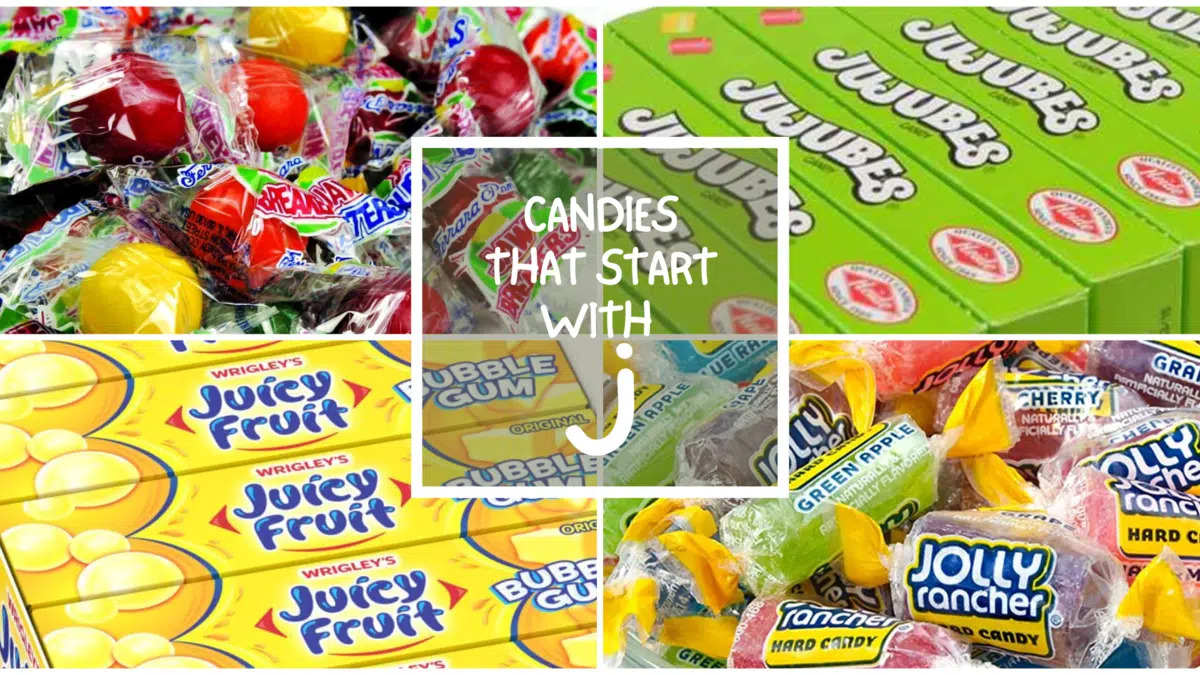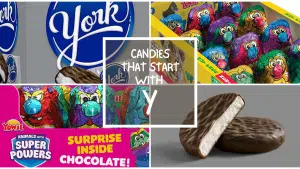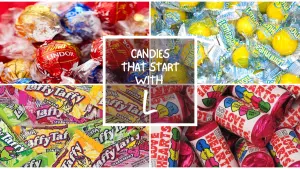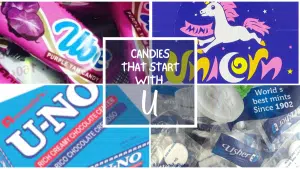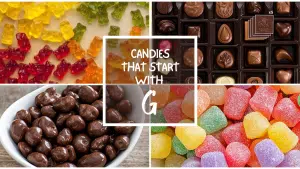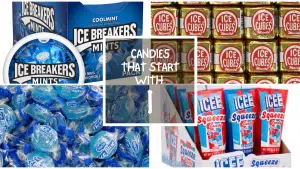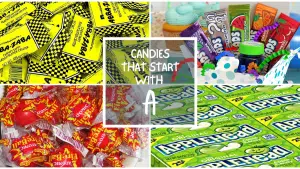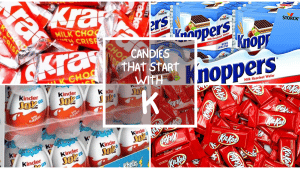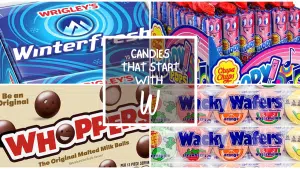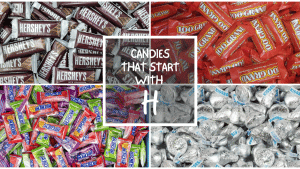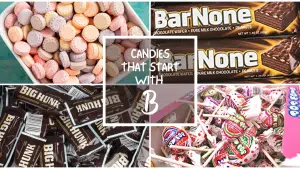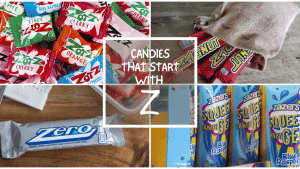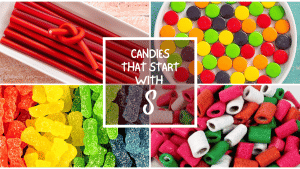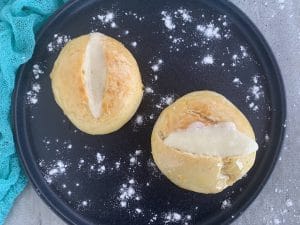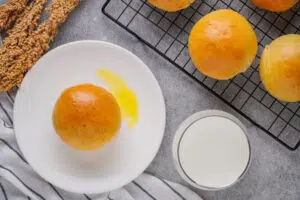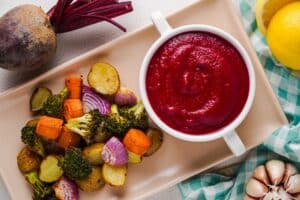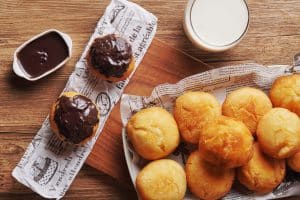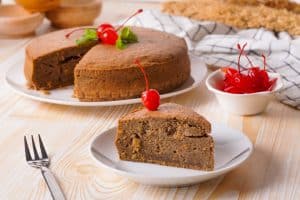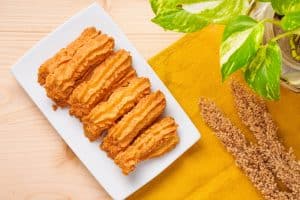All The Candies That Start With J
Important Note: When you buy through our links, we may earn a commission. As an Amazon Associate we earn from qualifying purchases. Content, pricing, offers and availability are subject to change at any time - more info.
Oh, what joy the J candies will conjure. From classic favorites straight from your youth to newfangled confections you can’t resist, the list of J candies is a good one. The J list highlights some of the hardest hard candies and meltiest chocolates you’ll ever taste. From classics like Jelly Beans to oddballs like Jelly Babies, you’re in for a real treat.
- Jawbusters
- Jelly Babies
- Jelly Belly Jelly Beans
- Jelly Rings
- Jolly Ranchers
- Jordan Almonds
- Juicy Fruit
- Jujubes
- Juju Coins
- Jumbo Push Pop
- Junior Mints
- The Final Letter
Jawbusters
Like the Everlasting Gobstopper, Jawbusters are a type of uber-hard candy made by Ferrara Candy Company. Jawbusters were first invented in the late 1800s and over the years have also been called Jawbreakers and Gobstoppers; essentially, they’re all the same. A Jawbuster starts with a microscopic sugar crystal at the candy’s core and is repeatedly coated with a hard candy shell to create a layered effect. There are typically around 10 coated layers and the process takes about four days to produce each candy. Named Jawbusters for the incredibly hard shell, these candies are meant to be sucked, not chewed.
Jawbusters are fruity and colorful and ever-changing; with each new layer, you’re greeted with an all-new fruit flavor. Jawbusters are ball-shaped and come in bright colors such as yellow, green, red, orange, and purple. The recipe for Jawbusters is simple; they’re made of sugar, corn starch, and a combination of artificial and natural flavors. A serving of Jawbusters, which amounts to three pieces, contains 70 calories and 17 grams of sugar. If food allergens are a concern, beware that Jawbusters are packaged in plants with milk, eggs, nuts, and soy.
Jelly Babies
Jelly Babies are exactly what they sound like, gummy candy in the shape of bite-sized babies; creepy, right? Historically speaking, Jelly Babies were invented in 1864 by Bassett’s Candy Company and though they’ve been discontinued and revived a handful of times since their invention, they are now produced by Haribo. At one point, however, Jelly Babies were rebranded as Peace Babies to signify the end of World War I.
Jelly Babies come in a variety of colors and flavors per package. For instance, there are red, yellow, pink, green, purple, and orange in the flavors strawberry, lemon, raspberry, lime, blackcurrant, and orange respectively. Of note, Jelly Babies are made with sugar, glucose syrup, water, and gelatine among other ingredients. Lastly, a single serving of Jelly Babies has 175 calories and 39 grams of sugar.
Jelly Belly Jelly Beans
The first production of what would eventually become Jelly Belly Jelly Beans as you know them today was with the invention of Mini Jelly Beans in 1965. As we know them today, Jelly Belly Jelly Beans came to fruition in 1976 with flavors like root beer, tangerine, cream soda, licorice, and grape. In the 1980s, many more flavor profiles were introduced to the Jelly Belly Jelly Beans family and they continue to grow to this day. Significantly, although they’re available year-round, Jelly Belly Jelly Beans are a very popular Easter Basket treat.
Moreover, Jelly Belly Jelly Beans can be purchased in individual packs, bulk bags, gift boxes, and both singular and mixed flavors. Furthermore, there are many special varieties of Jelly Belly Jelly Beans such as a Harry Potter collection, sugar-free jelly beans, and a sports collection to name a few. The primary ingredients in Jelly Belly Jelly Beans are sugar, corn syrup, and both natural and artificial flavors. Finally, a serving of Jelly Belly Jelly Beans, which is about 30 pieces, contains 110 calories and 21 grams of sugar.
Jelly Rings
Manufactured by Joyva, a chocolate and sweets producer based in Brooklyn, New York, Jelly Rings are a candy typically associated with celebrating. Jelly Rings are dark chocolate-covered raspberry-flavored jelly rings. Family-owned and in business since 1907, Joyva is best known for Jelly Rings though they make other candies such as chocolate-covered halvah and sesame crunch candy too. Jelly Rings come in five-pound boxes that are perfect for gift-giving or setting out at the holidays.
The main ingredients in Jelly Rings are sugar, corn syrup, chocolate, and artificial flavors. A serving of about six Jelly Rings has 190 calories, three grams of fat, and 22 grams of sugar. Laudably, these sweet treats are gluten-free, however, they are manufactured alongside soy, eggs, and tree nuts.
Jolly Ranchers
Jolly Ranchers first hit candy aisles in 1964 and have been a popular hard candy ever since. Founded by a married couple who owned the Jolly Rancher Company in Colorado, Jolly Ranchers got their start as a rectangular hard candy in a twist-tied cellophane wrapper. Today, however, Jolly Ranchers come in a variety of shapes and flavors; from lollipops to gummies and jelly beans to sour bites, Jolly Ranchers are a household name. The original flavors of Jolly Ranchers were watermelon, apple, and fire stix, but today other common flavors include cherry, lemon, orange, and grape. Interestingly, the most popular flavor has always been watermelon.
Today, Jolly Ranchers are produced by Hersheyland who acquired the popular candy brand in 1996. They are a popular Halloween treat and candy-dish sweet. Jolly Ranchers are made from corn syrup, sucrose, glucose, and fructose, and every three hard candies contain 70 calories and 11 grams of sugar. Unfortunately, they’re neither gluten-free nor vegan.
Jordan Almonds
Jordan Almonds purportedly date back to ancient Rome when honey-covered almonds were a celebratory sweet treat. Today, however, they’re manufactured by Capco Enterprises, Inc, a renowned candy maker. Jordan Almonds have long been a popular party favor; have you even lived if you’ve never received a satchel of Jordan Almonds as a wedding or shower favor? Classic Jordan Almonds come in lovely pastel colors and can be purchased in a mix of colors or in a singular color.
Jordan Almonds are made with sugar, almonds, wheat flour, and corn syrup. The center of a Jordan Almond is a crunchy, lightly-roasted almond which is then covered in a crunch candy shell. A serving, or one-third of a cup, of Jordan Almonds has 216 calories, nearly seven grams of fat, 23 grams of sugar, about two grams of dietary fiber, and about three grams of protein. If allergens are a concern, beware that Jordan Almonds may contain milk, soy, or other nuts.
Juicy Fruit
Developed by Wm. Wrigley Jr. Company in 1893, Juicy Fruit is a chewing gum with staying power. Juicy Fruit has been such a mainstay, in fact, that it’s even found its place in the National Museum of American History. Juicy Fruit is a tasty, fruit-flavored gum that comes in individually foil-wrapped stick-form.
Though the gum’s flavor is distinctly fruity, the brand never actually specifies which fruit flavor it’s modeled after, however, it’s noted as tasting much like a cross between pineapple and coconut. Juicy Fruit’s ingredients include gum base, sugar, corn syrup, and dextrose. Finally, a single stick of Juicy Fruit has 10 calories and two grams of sugar.
Jujubes
Introduced by a German candy maker in 1920, Jujubes are fat-free, chewy candy. Jujubes were named for the jujube tree fruit, which is akin to a date, that was once an ingredient in this confection. Originally manufactured by a company called Hiede, Jujubes were sold to Hershey in 1995 and later to Ferrara Candy Company which manufactures them today. Jujubes haven’t changed much since their invention. They’ve long been a stubby, cylindrical gummy candy that comes in a variety of flavors and colors. In a given box of Jujubes, you’ll enjoy cherry, lemon, lime, orange, and licorice candies.
If you’d like to get your hands on some of these classic, gummy candies, a popular seller of Jujubes is movie theaters. The most common ingredients in Jujubes are corn syrup, sugar, food starch, and mineral oil. A serving size that equals about eight pieces contains 120 calories and 18 grams of sugar.
Juju Coins
Juju Coins may not be worth much currency-wise, but these tasty coin-shaped candies are worth a try. Juju Coins are a retro candy that has long been manufactured by Blair Candy Company which is located in Altoona, Pennsylvania. Juju Coins are a fruity, red, coin-shaped candy that’s marked with a dollar sign on each side. They are chewy, sticky, and addicting. Though there is also a hot, cinnamon flavor that goes by the name Red Hot Juju Dollars, standard Juju Coins only come in cherry fruit flavor.
Juju Coins are predominantly made with corn syrup, sugar, citric acid, and both natural and artificial flavors. If you’ve got dietary restrictions, know that Juju Coins are manufactured in a facility with peanuts, tree nuts, soy, and milk. Lastly, Juju Coins have 120 calories and 21 grams of sugar per serving.
Jumbo Push Pop
A product of Topps Company, Inc, Jumbo Push Pops were first introduced in Taiwan in 1986. Today, Jumbo Push Pops are produced by Candy Mania. These gimmicky lollipops are cylindrical, hard candy in a push tube that’s as much fun for kids (and adults) to eat as they are tasty. Jumbo Push Pops are the larger answer to the original Push Pop variety. Jumbo Push Pops come in many delectable flavors including blue raspberry, watermelon, strawberry, and berry blast.
Besides the tasty variety of flavors, Push Pops come in various packaging varieties including Triple Power, Flip-n-Dip, Sliderz, and Push Pump Spray. Furthermore, the main ingredients in Jumbo Push Pops are corn syrup, sugar, wheat flour, and cornstarch. Lastly, each Jumbo Push Pop contains 60 calories and 10 grams of sugar.
Junior Mints
First introduced by the James O. Welch Company in Cambridge, Massachusetts in 1949, Junior Mints are a classic candy. Junior Mints have a gooey peppermint center with a dark chocolate coating that simply melts in your mouth. Junior Mints are similar in taste to York Peppermint Patties, however, they are smaller, bite-sized pellets. Junior Mints were purchased by Tootsie Roll Industries in 1993 and they still produce them in Cambridge, Massachusetts today.
Junior Mints have been a long-time movie theater favorite. If you know anything about the soft, melty finish of these candies, you know not to leave them in a hot car or out in the sun; the next time you go to grab a sweet pellet, they’ll surely be melted together in a great big glob. Though the standard mint flavor is the most popular, other varieties of Junior Mints include Junior Caramels, Junior Mint Minis, and Junior Mints Deluxe. The main ingredients in Junior Mints include sugar, semi-sweet chocolate, corn syrup, and confectioner’s glaze. A 12-piece serving of Junior Mints has 130 calories, two-and-a-half grams of fat, and 25 grams of sugar.
The Final Letter
Which of these J candies will you reach for first. If you’re looking for a classic sweet treat or a new favorite to add to your roster, these J candies surely won’t disappoint. Finally, if you’re interested in releasing some of those feel-good chemicals in your brain, these candies are some of the tastiest ways to do so.
